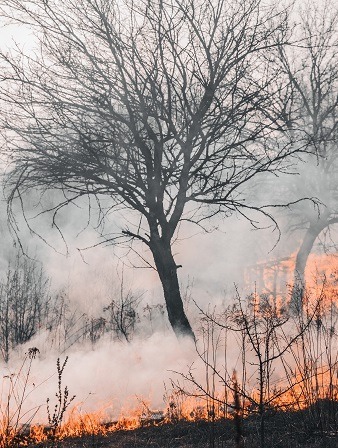
With climate change impacting more and more real estate, insurance keeps getting pricier. As we reported last year, mortgage lenders for coastal homes often expect 40% down payments, just to offset the risks. This year, the insurance tech company Policygenius published a study showing U.S. homeowners’ insurance rising at a remarkable 12%+ rate.
Among the top five reasons Policygenius lists for the rising premiums are “record catastrophe losses” and “severe natural disasters.”
Times are changing for real estate. And now, an industry is growing up around the concept of climate-resilient buildings. The largest investment fund in this area is being led by a firm named Fifth Wall.
Here’s the news on these developments.
Wildfire Is, Alas, Spreading…

A standard homeowner’s insurance policy includes wildfire damage in the policy holder’s coverage. But that is not an absolute rule, so you have to know your policy.
And it’s not cheap. The more wildfires damage properties, the more claims insurers have to process. Of course they are passing the expenses along to their loyal customers.
Another way insurance companies reduce their side of the risk is to deny claims if circumstances indicate that the homeowner could have taken fire-resistant measures, but failed to do so.
…But Water Presents the Biggest Risks.
Water damage is in play in about 90% of disasters, says the Pew Trust. U.S. homeowners might want to know about flood insurance.
Specifically, here’s why.
Seas are rising around North America. The rises involve warming water temperatures, combined with the melting of ice around the Earth. Scientists have reported significantly higher sea levels throughout the most recent thirty years.
Using satellites to collect information, NASA’s Sea Level Change Team has been studying those past three decades. Over the next three decades, the researchers say, sea levels could be a full foot higher than they are today.
☛ Climate disruption is now a key factor for house floods. The real estate world is just beginning to talk about this. In 2021, Hawaii began requiring sellers to disclose their properties’ sea-level rise risks.
Now, These Risks Are Moving Inland.
Rising sea levels, storm surges, and coastal erosion have washed out billions of home equity dollars in the mid-Atlantic and the Gulf states. When it comes to storm damage risk by state, Florida tops the list. The next riskiest states are Louisiana and Texas. Then New Jersey and New York.
Yet this is no longer a concern just for coastal states. It matters to real estate in general.
Tidal rivers bring sea level inland. Rising rivers are expected to affect millions of homes. Damage will be uneven, with some strongly impacted and others untouched. In certain areas, people will buy homes and find out they’re facing recurrent flooding. A nuisance? Definitely. And a loss risk.
Insurance generally won’t cover flooding — or any water damage beyond a sewer backup. But doesn’t the seller have to warn the buyer about the risks? Not necessarily. Even if sellers already know about a home’s risk of flooding, that doesn’t mean they must inform buyers. In a significant minority of states, flood risk disclosure isn’t mandatory.
☛ Some states don’t have flood disclosure laws to warn potential purchasers. One example: Florida, where storm surges are particularly impactful. Buyers, be alert!
The Federal Emergency Management Agency (FEMA) does issue coverage for real estate on flood hazard areas. Mortgage applicants may actually be required to buy flood insurance in flood zones. But FEMA bases its flood forecasts on past patterns. That is, major flood risks are present beyond FEMA’s designated Special Flood Hazard Areas.
In 2021, according to FirstStreet.org, FEMA finally recalibrated the agency’s risk assessments. The agency was so far behind that premiums for some properties suddenly rose by thousands of dollars a year! It was clear that the United States has urgently needed useful data on areas of land with unreported yet significant flood risks.
Can We Search for Our Own Climate Risks? Is There an App for This?
Count on it. We’re about to witness the rise of climate prediction and resilience technology and its adoption by insurance firms. Some examples of innovations? There’s Areahub.com, which helps “[d]iscover climate and environmental hazards around you.” Or try Climatecheck.com, for an instant risk assessment of climate impact on your home.
And then there’s the matter of dealing with building emissions. A venture capital firm for property tech, Fifth Wall, says climate tech will arise as a “retrofitting industry” and a “generational investment opportunity” for real estate investors. Fifth Wall set up its Climate Fund to address emissions from construction and from energy use in buildings. The firm says its fund will be an investment vehicle for indoor energy technology. It will also encourage adoption of wind and solar electric systems.
Fifth Wall’s fund has recently invested in an online platform for residential and commercial recycling, too. A Fifth Wall spokesperson calls RoadRunner Recycling a “game-changing approach to driving greater landfill diversion.” In plain terms, it automates the timing up of pick-ups to match when the receptacles fill up.
Fifth Wall’s limited partners for the technology investment fund include some of the wealthiest real estate companies in existence — the likes of Invitation Homes, American Homes 4 Rent, Kimco Realty Corporation, Hilton, and a slew of others.
And Here Are Our Key Takeaways.
Lending Tree puts the average homeowner’s flood insurance cost in 2022 as $82 per monthly payment. Given the damage caused by recent storms like Ida (2021) and Ian (2022), flood coverage will become more popular, despite this heavy cost for homeowners.
The industry is also watching the impact of winds and wildfires. Homeowners need to be aware of these developments and how they can prevent or at least mitigate the damage.
The premiums paid by property owners will continue to depend on state-specific and location-specific factors. But it’s likely that rising costs of hazards will impact insurance prices as a whole. Some 90% of surveyed homeowners told Policygenius that their premiums are already up over the past year.
The tech sector is swooping in, perceiving this issue as a massive opportunity. For homeowners, the matter looks quite different. All homeowners should take time to learn whether they’re covered for a climate-related calamity.
Supporting References
Internal Revenue Service: Tax Topic No. 515. Casualty, Disaster, and Theft Losses.
Pat Howard for Policygenius.com: Home Insurance Prices Are Rising Even Faster Than Inflation (Jul. 12, 2022; citing the 2022 Policygenius Home Insurance Pricing Report).
Insurance Journal: Home Insurance Prices Increase Faster Than Inflation Rate – Policygenius (Jul. 12, 2022).
Diana Olick for CNBC.com: Fifth Wall Closes Half-Billion-Dollar Climate Fund to Decarbonize Global Real Estate (Jul. 21, 2022).
Sally Younger, U.S. Jet Propulsion Laboratory (Pasadena): NASA Study – Rising Sea Level Could Exceed Estimates for U.S. Coasts (Nov. 15, 2022).
Kate Dore for CNBC.com: As Climate Change Threatens More Homes, Some Properties Are Getting Too Costly to Insure (updated Aug. 9, 2022).
Lending Tree via ValuePenguin.com: The Average Cost of Flood Insurance (updated Sep. 2022).
Deeds.com: How a Sudden Disaster Impacts Your Mortgage Loan (Apr. 12, 2021).
Deeds.com: Natural (and Other) Disasters: How Emergencies Impact Titles and Mortgages (Aug. 7, 2020).
And as linked.
Photo credits: Mikhail Nilov and Vladyslav Dukhin, via Pexels.
